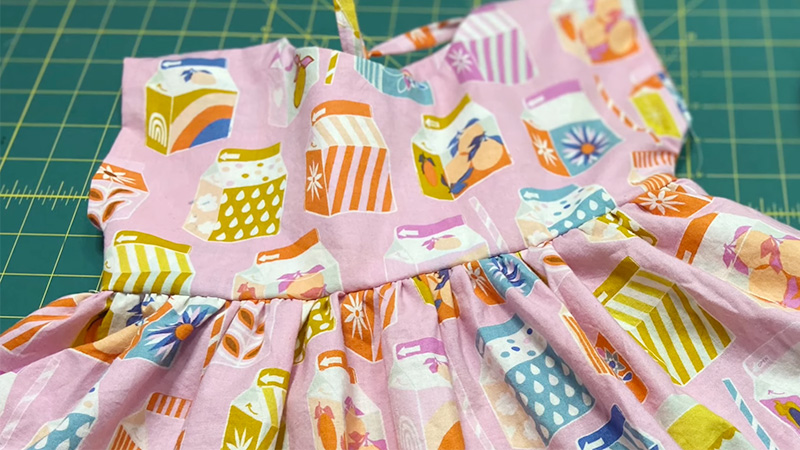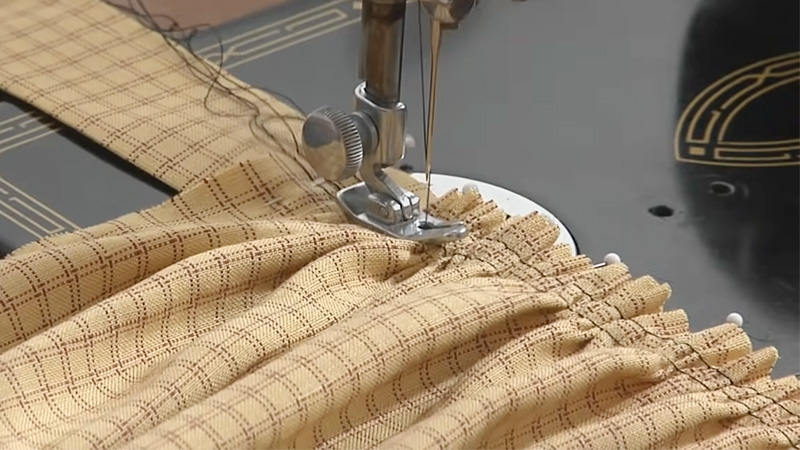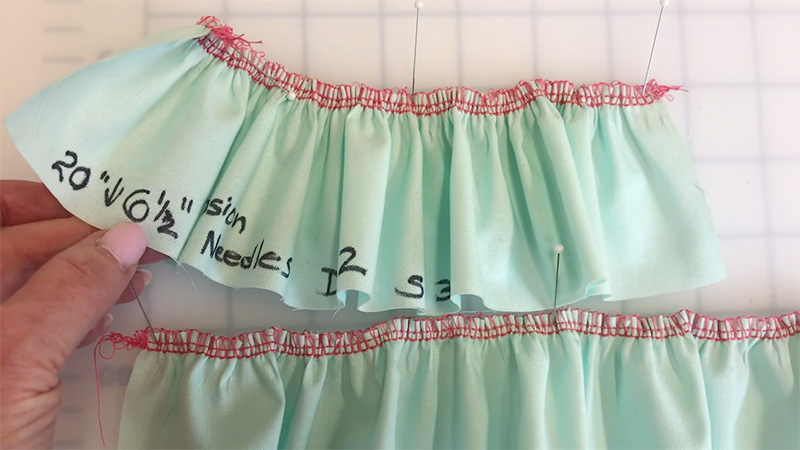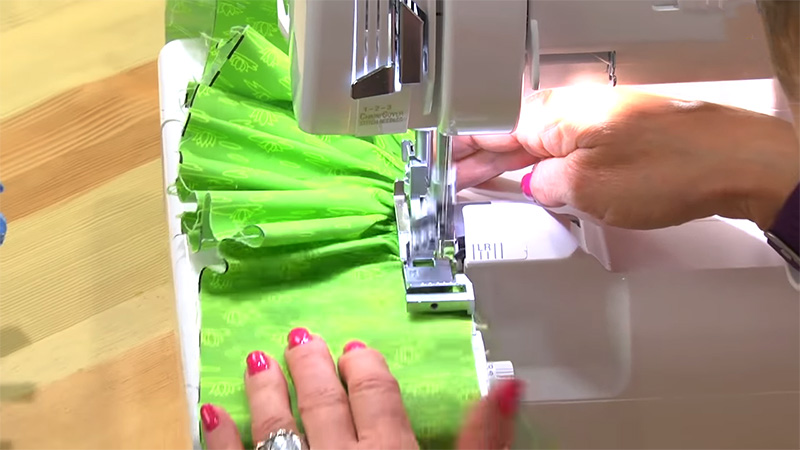Gathering fabric can add depth, texture, and dimension to your sewing projects, creating visually captivating and functional elements. When it comes to efficiency and precision in gathering, a serger or overlocker can be your best ally.
Learning how to gather on a serger opens up a world of possibilities, from creating ruffles to constructing shirred garments and adding decorative edging to gathered seams.
The serger’s differential feed and stitch versatility make it a versatile tool for achieving uniform gathers, whether for fashion, home décor, or crafts.
In this exploration of gathering on a serger, we will delve into the techniques, measurements, and practical steps to help you harness the full potential of your serger for precise and professional gathering.
Whether you’re a seasoned seamstress or a sewing novice, mastering this skill will elevate your sewing projects to a new level of creativity and finesse.

How To Gather On A Serger?
Gathering fabric on a serger can be a quick and efficient method, adding a lovely, even gather to your sewing projects.
Here are the simple methods for gathering fabric on a serger:
Differential Feed Adjustment
Most sergers have a differential feed mechanism that controls the front and rear feed dogs’ movement independently. To gather fabric, increase the differential feed ratio by setting the front feed dogs to move faster than the rear ones.
This causes the fabric to gather as it’s fed through the machine. Experiment with different settings to achieve the desired gather density.
Stitch Length Adjustment
Shorten the stitch length on your serger to create tighter gathers. Set the length to a smaller number, and as you serge the fabric, it will automatically gather. This method works well for lightweight fabrics.
Increase Tension on Needle Threads
Another way to gather with a serger is to increase the tension on the needle threads. This causes the fabric to gather as it passes through the machine. Be sure to adjust both needle thread tensions equally for balanced gathers.
Use a Gathering Foot
Some serger models offer a gathering foot or attachment. Attach this foot to your serger, and it will automatically gather the fabric as it feeds through. Consult your machine’s manual for instructions on using a gathering foot.
Gather Two Layers Simultaneously
For a more pronounced gather, feed two layers of fabric through the serger at once. As the serger stitches both layers together, it gathers them simultaneously, creating a denser gather.
Increase Differential Ratio Gradually
If your fabric is resistant to gathering, start with a slightly increased differential feed ratio and gradually adjust it until you achieve the desired gathering. This gradual approach allows you to control the amount of gather more precisely.
Test on Scrap Fabric
Before gathering your main fabric, practice on a scrap piece to fine-tune the settings and ensure the gather is to your liking. This helps you avoid mistakes on your actual project.
Gathering fabric on a serger can save time and produce neat, even gathers. However, it’s essential to practice and adjust your machine settings to achieve the perfect gather for your specific project and fabric type.
How Do You Get The Right Amount Of Gathering?

Getting the right amount of gathering in your sewing project is crucial for achieving the desired look and fit.
Here are the techniques to help you control and adjust the amount of gathering effectively:
Adjust Stitch Length
One of the simplest ways to control gathering is by adjusting the stitch length on your sewing machine. A shorter stitch length creates tighter gathers, while a longer stitch length results in looser gathers. Start with a longer stitch length and gradually decrease it until you achieve the desired amount of gather.
Use a Gathering Foot
Gathering feet, also known as ruffling feet, are specialized sewing machine feet designed for creating even gathers. Attach the gathering foot to your machine, and it will automatically gather the fabric as you sew. Adjust the foot’s settings to control the amount of gather.
Alter Thread Tension
Adjusting the thread tension on your sewing machine can influence the amount of gathering. Increase the tension on either the needle thread or bobbin thread to create more gather.
Experiment with tension settings until you achieve the desired result.
Change Gathering Ratio
If your sewing machine has a differential feed, use it to control gathering. Increase the differential feed ratio for more gathering and decrease it for less. This feature is especially helpful when working with a serger or overlocker.
Multiply Rows of Basting Stitches
Instead of using a single row of basting stitches to gather fabric, sew multiple parallel rows of basting stitches. The more rows you add, the tighter the gathering will be. Pull the bobbin threads to adjust the gathers evenly.
Measure and Pin
To ensure precise gathering, measure the fabric length you need to gather and mark it with pins or fabric chalk. Then, evenly distribute the gathers between the pins as you sew, ensuring uniformity in the gathered sections.
Calculate the Ratio
For precise control over gathering, calculate the ratio of the fabric length to the desired gathered length. Determine the amount of gather you need and adjust your stitch length, thread tension, or gathering method accordingly to achieve that ratio.
Achieving the right amount of gathering depends on your project’s requirements and your desired aesthetic.
By employing these techniques and practicing scrap fabric first, you can confidently control and adjust the gathering to meet your specific needs, whether it’s for ruffles, sleeves, or other gathered details in your sewing projects.
When To Gather With A Serger?

Gathering with a serger, also known as overlocking, can be a practical and efficient technique for various sewing projects.
Here are the reasons when and why you might choose to gather with a serger:
Creating Ruffles and Flounces
Sergers are excellent tools for quickly and evenly gathering fabric to create ruffles or flounces.
By adjusting the differential feed and stitch settings, you can achieve precise and consistent gathers for adding decorative elements to garments, curtains, or home décor.
Sewing Elastic Waistbands
Sergers are commonly used to attach elastic waistbands to skirts, pants, and shorts. The serger’s gathering capability helps distribute the elastic evenly while securing it to the fabric, ensuring a comfortable and snug fit.
Constructing Shirred Garments
Shirring involves using rows of parallel stitches to create stretchy and gathered sections in garments, often seen in the bodices of dresses, tops, and swimwear. A serger’s differential feed and stitch versatility make it ideal for shirring projects.
Adding Decorative Edging to Gathered Seams
Sergers can add decorative edging to gathered seams while gathering the fabric simultaneously. This is particularly useful for decorative stitching on the edges of gathered tiers or panels in clothing and home décor.
Quickly Hemming and Gathering at the Same Time
Some serger models offer the option to gather and hem fabric simultaneously. This time-saving feature is beneficial when working on projects with gathered hems, such as skirts, dresses, and curtains.
Constructing Tiered Skirts and Dresses
Tiered skirts and dresses often require multiple layers of gathered fabric. A serger can efficiently create gathers in each layer, ensuring uniformity and saving time during assembly.
Sewing Lingerie and Delicate Fabrics
Sergers equipped with differential feed are ideal for gathering delicate and lightweight fabrics used in lingerie and undergarments. The differential feed ensures even gathers without stretching or distorting the delicate material.
Knowing when to gather with a serger expands your sewing capabilities, making it easier to tackle a wide range of projects with efficiency and precision.
Whether you’re adding decorative details, constructing shirred garments, or creating tiered designs, a serger’s gathering function can help you achieve professional-looking results.
How To Work Out The Serger Gathering Ratio?

Working out the serger gathering ratio is crucial for achieving precise and uniform gathers in your sewing projects.
Here are the measurements and steps to help you calculate and control the gathering ratio effectively:
Determine Fabric Length
Measure the length of the fabric you want to gather. This measurement will serve as your starting point for gathering calculations. For instance, if you’re gathering a skirt panel, measure its width along the top edge.
Calculate Desired Final Length
Decide how long you want the gathered section to be after the gathering. This could be the final length of a ruffle, shirring section, or gathered waistband. Note down this desired final length.
Calculate the Gathering Ratio
Divide the desired final length by the original fabric length to calculate the gathering ratio. For example, if you want a gathered section that is half the original length, the gathering ratio is 0.5 (or 50%).
Adjust Differential Feed
On your serger, adjust the differential feed setting to match the gathering ratio you calculated. If you want a 50% gathering ratio, set the differential feed to 0.5. This setting controls how much the fabric is gathered during serging.
Test on Scrap Fabric
Always test the gathered seam on a scrap piece of fabric before sewing on your actual project. This step allows you to fine-tune the gathering ratio and ensure it meets your expectations.
Mark Placement Lines
To maintain control and accuracy, mark placement lines on your fabric where the gathering will begin and end. These lines will guide you as you feed the fabric through the serger.
Serge Along Placement Lines
With the differential feed and gathering ratio adjusted, carefully serge along the marked placement lines. As you sew, the serger will automatically gather the fabric according to the ratio you set.
By following these measurements and steps, you can calculate and achieve the desired gathering ratio with precision.
Whether you’re working on ruffles, shirring, or other gathered details in your sewing projects, this method ensures that your gathers are consistent and tailored to your specific design.
FAQs
How do I gather fabric using a serger?
To gather fabric with a serger, first adjust the machine’s differential feed to control the gathering ratio. Mark the desired gathering placement on your fabric and guide it through the serger.
As you serge along the marked lines, the serger will automatically create even gathers.
What is the differential feed on a serger, and why is it important for gathering?
The differential feed on a serger controls the movement of the front and rear feed dogs, which is essential for achieving precise gathers. Adjusting the differential feed ratio allows you to control the amount of gathering, making it a crucial feature for successful gathering on a serger.
Can I gather both lightweight and heavyweight fabrics with a serger?
Yes, sergers can be used to gather various fabric types, from lightweight to heavyweight. However, you may need to adjust the serger’s settings, such as the stitch length, tension, and differential feed, to accommodate different fabric thicknesses effectively.
Are there specific techniques for gathering on a serger for decorative edges?
Yes, you can create decorative edges with gathers on a serger. Adjust the differential feed and stitch settings to achieve the desired gather density while serging along the fabric’s edge. This technique adds a decorative touch to your gathered seams.
How can I ensure even gathers when gathering on a serger?
To ensure it even gathers, mark the gathering placement lines on your fabric and use pins or clips to hold them in place. Additionally, practice on scrap fabric first to fine-tune the settings and gather ratio, guaranteeing that your gathers are consistent and uniform across your project.
Conclusion
Gathering on a serger is a valuable technique that streamlines the process of creating even, consistent gathers in your sewing projects. With the right measurements, adjustments, and techniques, you can achieve the perfect gathering ratio for various applications, from delicate shirring to tiered skirts and decorative edging.
By understanding how to work with your serger’s differential feed and stitch settings, you gain the ability to control the degree of gathering with precision and confidence.
Whether you’re adding a touch of elegance to your garments or enhancing the aesthetics of your home décor, gathering on a serger empowers you to create polished and professional finishes.
As you continue to explore the world of sewing, this skill will undoubtedly become a valuable tool in your repertoire, allowing you to turn your creative visions into beautifully gathered realities.
Leave a Reply